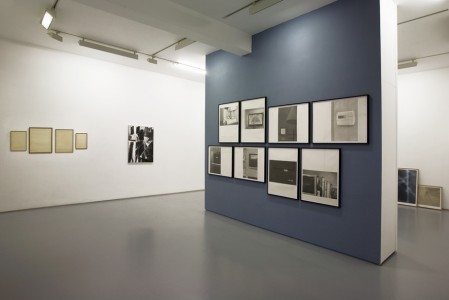Blind Mirror
19 Mar - 30 Apr 2010
BLIND MIRROR
Danilo Correale - Liz Deschenes - Karl Haendel - Benoit Maire - R.H. Quaytman - Eileen Quinlan - David Robbins - Cheyney Thompson - Johan Thurfjell
Opening friday 19 march – from 7 pm to 9,30 pm
From 19 march to 30 april 2010
Gallery B
Reflected images are not always objective. In the understanding of what gives us back the reflection of our image, in the extended sense, several factors are involved, especially psychological, adapting the image to acceptance or rejection. Traditionally, one is led to think that in a photographic image, because of its documental characteristic of transcript of reality, mainly lies the character of objectivity. Paradoxically, however, in this exquisitely technical means of recording of reality, intervene personal characteristics, spatial and optical limits, and also the experimental ones of photographic technique, which subvert the assertion of its unquestionable objectivity. The technique used for the production of the photographic image can be connected to the equipment used and other gradients so to reconsider it as a means of reinventing reality as in painting or drawing. The framework, the quality of chemical compounds, time-related exposure, and finally the new reproductive techniques, suggest new reflections and reading of photography, even in the light of its history.
The concept of reproducibility of the work, also linked to a massive spread of the image and so to its marketing, is the subject of new analysis up to the study of the infinitesimal points that compose it. The mythological character of the representation of an image, in the meaning of paralyzation of reality, not only takes up new formal features, that hybridize painting with picture, but also rethinks the philosophical and conceptual features of the representation. This may lead one to suppose that the real is no longer enough and that its re-interpretation might lead to a new feeling, poetic or analytical, which leads us to reflect on the real consideration of the image content alienating the seductive preconceptions of its systematic assimilation and duplication of passive acceptance.
It's obvious that talking about art we should consider the ability and willingness revived by the artist of formalizing with new techniques, new experiments and studies, what is implicit in the subliminal messages of the image codes to the abstraction of the contents of the object taken into consideration. Not always the road to take is easy, and it is tortuous to those who intend to look beyond the back of the mirror
Danilo Correale - Liz Deschenes - Karl Haendel - Benoit Maire - R.H. Quaytman - Eileen Quinlan - David Robbins - Cheyney Thompson - Johan Thurfjell
Opening friday 19 march – from 7 pm to 9,30 pm
From 19 march to 30 april 2010
Gallery B
Reflected images are not always objective. In the understanding of what gives us back the reflection of our image, in the extended sense, several factors are involved, especially psychological, adapting the image to acceptance or rejection. Traditionally, one is led to think that in a photographic image, because of its documental characteristic of transcript of reality, mainly lies the character of objectivity. Paradoxically, however, in this exquisitely technical means of recording of reality, intervene personal characteristics, spatial and optical limits, and also the experimental ones of photographic technique, which subvert the assertion of its unquestionable objectivity. The technique used for the production of the photographic image can be connected to the equipment used and other gradients so to reconsider it as a means of reinventing reality as in painting or drawing. The framework, the quality of chemical compounds, time-related exposure, and finally the new reproductive techniques, suggest new reflections and reading of photography, even in the light of its history.
The concept of reproducibility of the work, also linked to a massive spread of the image and so to its marketing, is the subject of new analysis up to the study of the infinitesimal points that compose it. The mythological character of the representation of an image, in the meaning of paralyzation of reality, not only takes up new formal features, that hybridize painting with picture, but also rethinks the philosophical and conceptual features of the representation. This may lead one to suppose that the real is no longer enough and that its re-interpretation might lead to a new feeling, poetic or analytical, which leads us to reflect on the real consideration of the image content alienating the seductive preconceptions of its systematic assimilation and duplication of passive acceptance.
It's obvious that talking about art we should consider the ability and willingness revived by the artist of formalizing with new techniques, new experiments and studies, what is implicit in the subliminal messages of the image codes to the abstraction of the contents of the object taken into consideration. Not always the road to take is easy, and it is tortuous to those who intend to look beyond the back of the mirror

